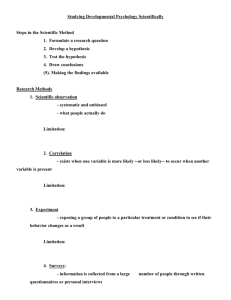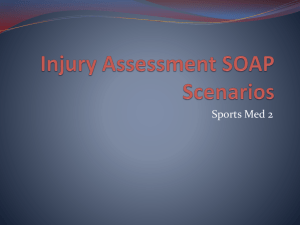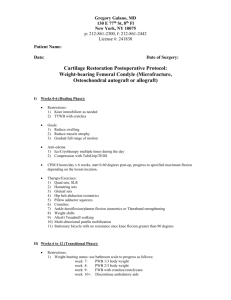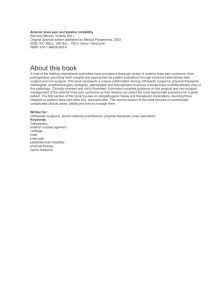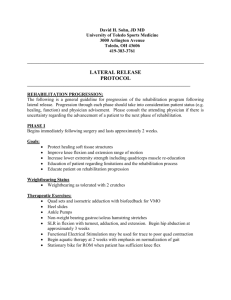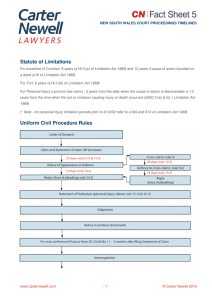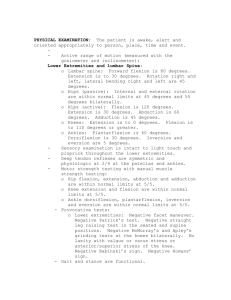Properly Evaluating Knee Disabilities
advertisement
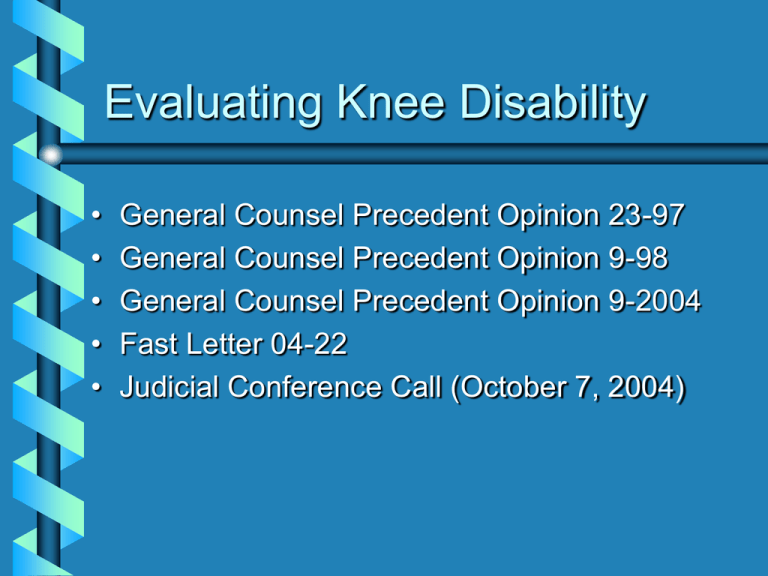
Evaluating Knee Disability • • • • • General Counsel Precedent Opinion 23-97 General Counsel Precedent Opinion 9-98 General Counsel Precedent Opinion 9-2004 Fast Letter 04-22 Judicial Conference Call (October 7, 2004) Avoidance of Pyramiding • 38 CFR §4.14 states, in part – “The evaluation of the same disability under various diagnoses is to be avoided.” Avoidance of Pyramiding • VA General Counsel has determined the knee joint may be evaluated under multiple diagnostic codes when there are different manifestations of the same disability. General Counsel Opinion 23-97 – Multiple Ratings for Knee Disability • When a claimant has arthritis and instability of the knee, does 38 CFR §4.71(a) authorize multiple ratings under diagnostic codes 5003 and 5257? VAOPGC PREC 23-97 • DC 5257 provides for evaluation of instability of the knee without reference to limitation of motion. • DC 5003, on the other hand, refers to xray evidence and limitation of motion. It does not reference instability of a joint. Rating Schedule 38 CFR §4.71(a) • 5257: instructs that recurrent subluxation or lateral instability be rated as slight, moderate, or severe. • 5003 (5010): instructs that arthritis will be rated on the basis of limitation of motion under the appropriate diagnostic codes for the specific joint or joints involved. (e.g., 5003-5260) If a compensable evaluation is not warranted under the limitation of motion code, a 10 percent is for application for each major joint or group of minor joints affected by limitation of motion which is confirmed by objective findings of swelling, muscle spasm, or evidence of painful motion. VAOPGC PREC 23-97 • Since the plain terms of DC 5257 and 5003 suggest that those codes apply either to different disabilities or different manifestations of the same disability, the evaluation of knee dysfunction under both codes would not amount to pyramiding. VAOPGC PREC 23-97 • HELD: –A claimant who has arthritis and instability of the knee may be rated separately under diagnostic codes 5003 (limitation of motion) and 5257 (instability). Additional Considerations When determining the evaluation under 5003 and other limitation of motion diagnostic codes (5260, 5261,etc.), consider: • §4.40: Functional loss. • §4.45: The joints. • §4.59: Painful motion. 38 CFR §4.40 • Functional loss. Disability of the musculoskeletal system is primarily the inability, due to damage or infection in parts of the system, to perform the normal working movements of the body with normal excursion, strength, speed, coordination and endurance …. Weakness is as important as limitation of motion, and a part which becomes painful on use must be regarded as seriously disabled. 38 CFR §4.45 • The joints. Consideration should be given to: – Less movement than normal – More movement than normal – Weakened movement – Excess fatigability – Incoordination – Pain on movement, swelling, deformity, or atrophy of disuse. 38 CFR §4.40 Functional Loss. and §4.45 The Joints. • DeLuca v. Brown: The Court held that consideration of the provisions of 38 CFR §4.40 and §4.45 when evaluating disabilities involving the joints is required. • This was repeatedly stated in other Court decisions prior to DeLuca; most notably: Schafrath v. Derwinski; Quarles v. Derwinski; and Ferraro v. Derwinski. 38 CFR §4.59 • Painful Motion. With any form of arthritis, painful motion is an important factor of disability… It is the intention to recognize actually painful, unstable, or malaligned joints, due to healed injury, as entitled to at least the minimum compensable rating for the joint. 38 CFR §4.59 Painful Motion • Lichtenfels v Derwinski: While there may be no limitation of motion (which is usually noncompensable under DC for limitation of motion), a compensable rating may be granted where there is painful motion. In arthritis, painful motion is an important factor of disability, which should be carefully noted and definitely related to affected joints. It is the intention to recognize actually painful joints, due to healed injury, as entitled to at least the minimum compensable rating for the joint. Functional Loss and Pain • Impact and severity of pain must be considered by applying 38 CFR §4.40, §4.45, and §4.59. • The regulation §4.40 does not require a separate rating for pain, but the impact of pain must be considered in the rating. (Spurgeon V. Brown; VAOPGCPREC 9-98) • Diagnostic codes, which are based on limitation of motion, do not subsume functional loss due to pain. (DeLuca V. Brown) • Functional loss due to pain must be supported by adequate pathology, and evidence by the visible behavior of the claimant. (Johnston v. Brown) General Counsel Opinion 9-98 – Multiple Ratings for Musculoskeletal Disability and Application of 38 CFR §4.40, § 4.45, and § 4.59 • Held: – For a knee disability rated under DC 5257 to warrant a separate rating for arthritis based on x-ray evidence findings and limitation of motion, limitation of motion under DC 5260 or DC 5261 need not be compensable but must at least meet the criteria for a zero-percent rating. A separate rating for arthritis could also be based on X-ray findings and painful motion under 38 CFR §4.59. VAOPGCPREC 9-98 • Held: – The provisions of 38 CFR §4.40, §4.45, and §4.59 must be considered in assigning an evaluation for degenerative arthritis or traumatic arthritis under DC 5003 or DC 5010. Rating Personnel must consider functional loss and clearly explain the impact of pain upon the disability. VAOPGCPREC 9-98 • Held: – If a musculoskeletal disability is rated under a specific diagnostic code that does not involve limitation of motion and another diagnostic code based on limitation of motion may be applicable, the latter diagnostic code must be considered in light of sections §4.40, §4.45, and §4.59. Example • Service connection is warranted for a veteran’s arthritis and instability of the right knee. Examination shows limitation of flexion of the right knee to 45 degrees with pain and mild instability. There is no additional functional loss with repetitive use. How should the veteran’s knee disability be evaluated? Example • 5003-5260 (or 5010-5260) – Arthritis of the right knee with limitation of flexion – 10 percent (based on requirements of 5260 being met - no additional functional limitations above the 10 percent is shown) • AND • 5257 – Instability of the right knee – 10 percent Example • Service connection is warranted for a veteran’s arthritis and instability of the right knee. Examination shows limitation of extension of the right knee to 2 degrees with objective evidence of pain and mild instability. There is no additional functional loss with repetitive use. How should the veteran’s knee disability be evaluated? Example • 5261-5003 (or 5261-5010) – Arthritis of the right knee with slight limitation of motion with pain – 10 percent (consideration of pain under 5003 for a major joint and 4.40, 4.45, and 4.59) AND • 5257 – Instability of the right knee – 10 percent FAQ – Q&A Committee • If a veteran has ligament instability and limited range of motion, but no arthritis present, can separate compensable evaluations be assigned under DC 5257 and under DC 5260 OR 5261? FAQ – Q&A Committee • Separate evaluations MAY be assigned if there is instability and limitation of motion due to disease or injury other than arthritis. FAQ – Q&A Committee • If both lateral instability and limitation of motion are found, separate evaluations would probably be warranted. • Consideration of 38 CFR §4.40, §445, and §4.59 must be considered with the diagnostic code involving the limitation of motion criteria. Example • Service connection is warranted for a veteran’s patellofemoral pain syndrome status post ACL repair and instability of the right knee. Examination shows limitation of flexion of the right knee to 112 degrees with objective evidence of pain and mild instability. There is no additional functional loss with repetitive use. How should the veteran’s knee disability be evaluated? Example • 5260 – Patellofemoral pain syndrome of the right knee with limitation of flexion – 10 percent (considering §4.40, §4.45, and §4.59) AND • 5257 – Instability of the right knee – 10 percent Rating Limitation of Flexion and Extension of the Leg • General Counsel Opinion 9-2004 – Held: Separate ratings under DC 5260 (limitation of flexion) and DC 5261 (limitation of extension) may be assigned for disability of the same joint. • Fast Letter 04-22 – Where a veteran meets the requirements for a 0 percent or higher evaluation under DC 5260 and under DC 5261, an evaluation under each diagnostic code may be assigned. Rating Limitation of Flexion and Extension of the Leg • Do not consider evaluating a knee joint under both diagnostic codes 5260 and 5261 unless the actual limitation of motion of the knee meets the schedular requirements for at least a noncompensable evaluation. STAR Error • RD dtd 6/29/09 cont a 10% eval under DC 5260 based on LOM of flexion to 90 degrees & painful motion. However, RD dtd 9/30/08 assigned a sep 10% eval under DC 5261 based on LOM of ext to 10 degrees. Multiple evaluations under multiple dcs for a single knee is not warranted unless the requirements for a 0% or higher eval is met. DC 5260 requires LOM on flexion to 60 degrees for a sep eval. Sep 10% eval not warranted. Chg in combined eval eff 11/21/08. VAOGCPREC 998;38CFR4.14;FL 04-22;38CFR3.105(a) STAR Error • RD dtd 12-5-08 incorrectly states extension is normal for the right knee. VAE indicates extension limited to 10 degrees. Because flexion does not meet the 0% criteria, separate eval for flexion and extension are not warranted. VAOPGCPREC 9-04 and M21-1MR III.iv.6.C.11.a STAR Error • The rating fails to explain the basis of the 10% evaluation as required per M21-1 MR III.iv.6.C.11.a.& c. The rating cited 10% criteria under 38 CFR 4.71a DCs 5259, 5260, & 5261 - all of which are not applicable as there is no semilunar cartilage removal, flexion is not 45 degrees or less, & extension is not less 10 degrees. The rating appears to note the dx of knee strain is being rated analogous to cartilage removal which is not in compliance with 38 CFR 4.20. STAR Error • The rating incorrectly assigned 2 compensable evaluations based on R knee flexion & extension. The veteran does not meet the noncompensable criteria under 38 CFR 4.71 DC 5260. 38 CFR 4.59 does not apply regarding a separate evaluation in this case as R knee LOM warrants compensation under DC 5261. STAR Error • RD assigned a 10% evaluation for RT knee flx under DC 5260 for painful motion (PM). 10% evaluations were properly assigned for ext based on LOM (DC 5261) & instability (DC 5257). A 10% evaluation is warranted for PM under DC 5260 or 5261 where no compensable LOM is demonstrated per the Schedule. Since a 10% evaluation was assigned for ext, a separate compensable evaluation is not warranted for flx unless it meets DC 5260 criteria. REF: 38CFR 4.59; 4.71a DC 5260 & 5261; FL 04-22; VAOPGCPREC 9-2004 VAOPGCPREC 9-2004 Examples Range of motion is 0 degrees of extension and 30 degrees of flexion. Question: Can you grant two separate evaluations? VAOPGCPREC 9-2004 • Answer: – No, two separate evaluations are not warranted. – 20 percent under DC 5260, limitation of flexion, would be granted – A disability rating under DC 5261 would not be in order as extension is not limited to 5 degrees. VAOPGCPREC 9-2004 Examples Range of motion is 30 degrees of extension and 90 degrees of flexion. Question: Can you grant two separate evaluations? VAOPGCPREC 9-2004 • Answer: – No, two separate evaluations are not warranted. – 40 percent under DC 5261, limitation of extension, would be granted – A disability rating under DC 5260 would not be in order as flexion is not limited to 60 degrees. VAOPGCPREC 9-2004 Examples Range of motion is 15 degrees of extension and 45 degrees of flexion. Question: Can you grant two separate evaluations? VAOPGCPREC 9-2004 • Answer: – Yes, two separate evaluations are warranted. – 10 percent under DC 5260, limitation of flexion, would be granted – 20 percent under DC 5261, limitation of extension Rating Limitation of Flexion and Extension of the Leg and Consideration of 38 CFR §4.40, §4.45, and §4.59 • If you can grant evaluations under both extension and flexion: – Consideration of the provisions of 38 CFR §4.40, §4.45, and §4.59 must be considered. Where knee motion is actually impeded by pain, fatigability, weakness, etc., the evaluation assigned based on limitation of motion must consider the level at which motion is limited. – Judicial Review Conference Call dated October 7, 2004 clarified that the medical examination report must show the additional limitation of motion caused by pain, fatigability, or weakness (actual range of motion). Example • Full range of motion is shown on examination, but on repetitive use, extension is limited to 10 degrees and flexion is limited to 45 degrees due to fatigue. • Question: • Can you grant two separate evaluations? Example • Yes, two separate evaluations are warranted • 10 percent under DC 5260, limitation of flexion, would be granted • 10 percent under DC 5261, limitation of extension, would be granted Rating Limitation of Flexion and Extension of the Leg and Consideration of 38 CFR §4.40, §4.45, and §4.59 • Where joint motion is not limited, but there is objective evidence of pain on motion, whether in flexion, extension, or both, only one compensable evaluation would be warranted under EITHER diagnostic code 5260 OR 5261. Example • Full range of motion is shown on examination, but on repetitive use, objective evidence of pain is shown with extension and with flexion at end-points of movement • Question: • Can you grant two separate evaluations? Example • No, two separate evaluation are not warranted. • Either a 10 percent evaluation could be assigned under 5260 or 5261. Rating Limitation of Flexion and Extension of the Leg and Consideration of 38 CFR §4.40, §4.45, and §4.59 • If there is compensable limitation of flexion and extension and there is objective evidence of pain on motion, but such pain does not actually impede motion consider elevating one of the compensable evaluations, if it is determined that the painful motion results in additional disability beyond that reflected in the measured limitation of motion. To elevate both evaluations based on painful motion would constitute pyramiding. Example • Range of motion is 10 degrees of extension and 45 degrees of flexion. The examiner stated that there is additional functional loss due to pain, incoordination, impaired ability to execute skill movements smoothly, and fatigability • Question: • Can you grant two separate evaluations? Example • Yes, two separate evaluations are warranted • 10 percent under DC 5260, limitation of flexion, would be granted • 10 percent under DC 5261, limitation of extension, would be granted • Consideration would be given to elevating ONE of the evaluations to 20 percent, if it was determined that additional disability is present beyond that reflected in the measured limitation of motion. Evaluating Knee Disability • There is a possibility that a single knee could be evaluated under three DC codes. • If, – There is objective evidence of instability – Flexion is limited to at least 60 degrees – Extension is limited to at least 5 degrees • Then, three evaluations would be warranted. Questions??
